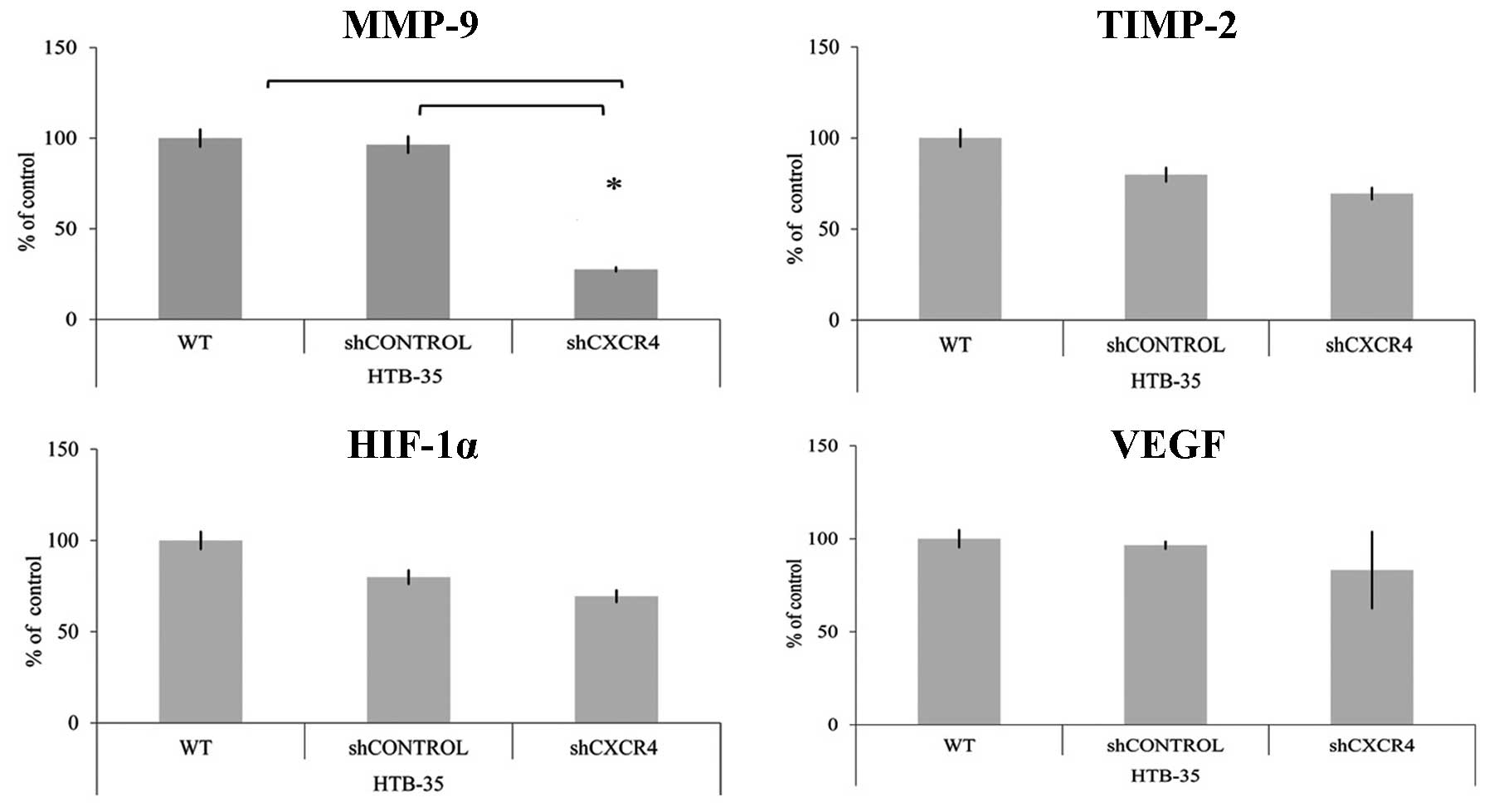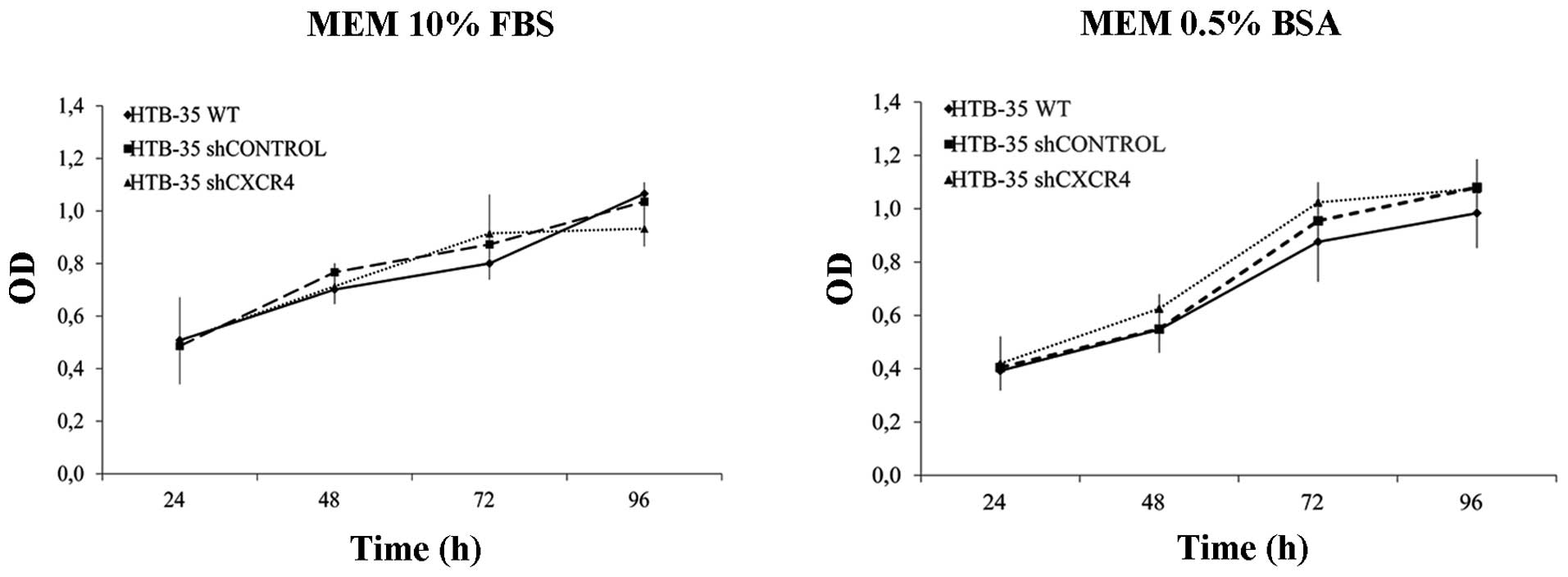|
1.
|
Zlotnik A and Yoshie O: Chemokines: a new
classification system and their role in immunity. Immunity.
12:121–127. 2000. View Article : Google Scholar
|
|
2.
|
Zlotnik A: Chemokines and cancer. Int J
Cancer. 119:2026–2029. 2006. View Article : Google Scholar : PubMed/NCBI
|
|
3.
|
Braunersreuther V, Mach F and Steffens S:
The specific role of chemokines in atherosclerosis. Thromb Haemost.
97:714–721. 2007.PubMed/NCBI
|
|
4.
|
Ara T, Tokoyoda K, Sugiyama T, Kawabata K,
et al: Long-term hematopoietic stem cells require stromal
cell-derived factor-1 for colonizing bone marrow during ontogeny.
Immunity. 19:257–267. 2003. View Article : Google Scholar : PubMed/NCBI
|
|
5.
|
Taichman RS, Cooper C, Keller ET, et al:
Use of the stromal cell-derived factor-1/CXCR4 pathway in prostate
cancer metastasis to bone. Cancer Res. 62:1832–1837.
2002.PubMed/NCBI
|
|
6.
|
Kato M, Kitayama J, Kazama S and Nagawa H:
Expression pattern of CXC chemokine receptor-4 is correlated with
lymph node metastasis in human invasive ductal carcinoma. Breast
Cancer Res. 5:144–150. 2003. View
Article : Google Scholar : PubMed/NCBI
|
|
7.
|
Kucia M, Jankowski K, Reca R, et al:
CXCR4-SDF-1 signalling, locomotion, chemotaxis and adhesion. J Mol
Histol. 35:233–245. 2004. View Article : Google Scholar : PubMed/NCBI
|
|
8.
|
Helbig G, Christopherson KW,
Bhat-Nakshatri P, et al: NF-kappaB promotes breast cancer cell
migration and metastasis by inducing the expression of the
chemokine receptor CXCR4. J Biol Chem. 278:21631–21638. 2003.
View Article : Google Scholar : PubMed/NCBI
|
|
9.
|
Liang Z, Yoon Y, Votaw J, et al: Silencing
of CXCR4 blocks breast cancer metastasis. Cancer Res. 65:967–971.
2005.PubMed/NCBI
|
|
10.
|
Kucia M, Reca R, Miekus K, et al:
Trafficking of normal stem cells and metastasis of cancer stem
cells involve similar mechanisms: pivotal role of the SDF-1-CXCR4
axis. Stem Cells. 23:879–894. 2005. View Article : Google Scholar : PubMed/NCBI
|
|
11.
|
Shiozawa Y, Nie B, Pienta KJ, et al:
Cancer stem cells and their role in metastasis. Pharmacol Ther.
138:285–293. 2013. View Article : Google Scholar : PubMed/NCBI
|
|
12.
|
Raman D, Baugher PJ, Thu YM and Richmond
A: Role of chemokines in tumor growth. Cancer Lett. 256:137–165.
2007. View Article : Google Scholar : PubMed/NCBI
|
|
13.
|
Teicher BA and Fricker SP: CXCL12
(SDF-1)/CXCR4 pathway in cancer. Clin Cancer Res. 16:2927–2931.
2010. View Article : Google Scholar : PubMed/NCBI
|
|
14.
|
Orimo A, Gupta PB, Sgroi DC, et al:
Stromal fibroblasts present in invasive human breast carcinomas
promote tumor growth and angiogenesis through elevated SDF-1/CXCL12
secretion. Cell. 121:335–348. 2005. View Article : Google Scholar : PubMed/NCBI
|
|
15.
|
Pecorino L: Molecular Biology of Cancer.
Oxford University Press; 2012
|
|
16.
|
LaBarge MA: The difficulty of targeting
cancer stem cell niches. Clin Cancer Res. 16:3121–3129. 2010.
View Article : Google Scholar : PubMed/NCBI
|
|
17.
|
Majka M, Drukala J, Lesko E, et al: SDF-1
alone and in co-operation with HGF regulates biology of human
cervical carcinoma cells. Folia Histochem Cytobiol. 44:155–164.
2006.PubMed/NCBI
|
|
18.
|
Schiffman M, Wentzensen N, Wacholder S, et
al: Human papillomavirus testing in the prevention of cervical
cancer. J Natl Cancer Inst. 103:368–383. 2011. View Article : Google Scholar : PubMed/NCBI
|
|
19.
|
Kodama J, Hasengaowa, Kusumoto T, et al:
Association of CXCR4 and CCR7 chemokine receptor expression and
lymph node metastasis in human cervical cancer. Ann Oncol.
18:70–76. 2007. View Article : Google Scholar : PubMed/NCBI
|
|
20.
|
González Martín A: Molecular biology of
cervical cancer. Clin Transl Oncol. 9:347–354. 2007.
|
|
21.
|
Sharp FA: RNA interference - 2001. Genes
Dev. 15:485–490. 2001. View Article : Google Scholar
|
|
22.
|
Felekkis K and Deltas C: RNA
intereference: a powerful laboratory tool and its therapeutic
implications. Hippokratia. 10:112–115. 2006.PubMed/NCBI
|
|
23.
|
Wu J, Chen C and Zhao KN:
Phosphatidylinositol 3-kinase signaling as a therapeutic target for
cervical cancer. Curr Cancer Drug Targets. 13:143–156. 2013.
View Article : Google Scholar : PubMed/NCBI
|
|
24.
|
Smith M, Luker KE, Garbow JR, et al: CXCR4
regulates growth of both primary and metastatic breast cancer.
Cancer Res. 64:8604–8612. 2004. View Article : Google Scholar : PubMed/NCBI
|
|
25.
|
Kruse AJ, Baak JPA, de Bruin PC, et al:
Ki-67 immunoquantitation in cervical intraepithelial neoplasia
(CIN): a sensitive marker for grading. J Pathol. 193:48–54. 2001.
View Article : Google Scholar : PubMed/NCBI
|
|
26.
|
Fasching PA, Heusinger K, Haeberle L, et
al: Ki-67, chemo-therapy response, and prognosis in breast cancer
patients receiving neoadjuvant treatment. BMC Cancer. 11:486–499.
2011. View Article : Google Scholar : PubMed/NCBI
|
|
27.
|
Martin B, Paesmans M, Mascaux C, et al:
Ki-67 expression and patients survival in lung cancer: systematic
review of the literature with meta-analysis. Br J Cancer.
91:2018–2025. 2004. View Article : Google Scholar : PubMed/NCBI
|
|
28.
|
Locke M, Heywood M, Fawell S and Mackenzie
IC: Retention of intrinsic stem cell hierarchies in
carcinoma-derived cell lines. Cancer Res. 65:8944–8950. 2005.
View Article : Google Scholar : PubMed/NCBI
|
|
29.
|
Li H, Chen X, Calhoun-Davis T, et al: PC3
human prostate carcinoma cell holoclones contain self-renewing
tumor-initiating cells. Cancer Res. 68:1820–1825. 2008. View Article : Google Scholar : PubMed/NCBI
|
|
30.
|
Papini S, Grivel JC, Cecchetti D, et al:
Isolation and clonal analysis of human epidermal keratinocyte stem
cells in long-term culture. Stem Cells. 21:481–494. 2003.
View Article : Google Scholar : PubMed/NCBI
|
|
31.
|
Barrandon Y and Green H: Three clonal
types of keratinocyte with different capacities for multiplication.
Proc Natl Acad Sci USA. 84:2302–2306. 1987. View Article : Google Scholar : PubMed/NCBI
|
|
32.
|
Allinen M, Beroukhim R, Cai L, et al:
Molecular characterization of the tumor microenvironment in breast
cancer. Cancer Cell. 6:17–32. 2004. View Article : Google Scholar : PubMed/NCBI
|
|
33.
|
Miekus K, Lukasiewicz E, Jarocha D, et al:
The decreased meta-static potential of rhabdomyosarcoma cells
obtained through MET receptor downregulation and the induction of
differentiation. Cell Death Dis. 17:e4592013. View Article : Google Scholar : PubMed/NCBI
|
|
34.
|
Muller A, Homey B, Soto H, et al:
Involvement of chemokine receptors in breast cancer metastasis.
Nature. 410:50–56. 2001. View
Article : Google Scholar : PubMed/NCBI
|
|
35.
|
Davidson B, Goldberg I, Kopolovic J, et
al: MMP-2 and TIMP-2 expression correlates with poor prognosis in
cervical carcinoma - a clinicopathologic study using
immunohisto-chemistry and mRNA in situ hybridization. Gynecol
Oncol. 73:372–382. 1999. View Article : Google Scholar : PubMed/NCBI
|
|
36.
|
Zhai Y, Hotary KB, Nan B, et al:
Expression of membrane type 1 matrix metalloproteinase is
associated with cervical carcinoma progression and invasion. Cancer
Res. 65:6543–6550. 2005. View Article : Google Scholar : PubMed/NCBI
|
|
37.
|
Sheu BC, Lien HC, Ho HN, et al: Increased
expression and activation of gelatinolytic matrix
metalloproteinases is associated with the progression and
recurrence of human cervical cancer. Cancer Res. 63:6537–6542.
2003.PubMed/NCBI
|
|
38.
|
Arsham AM, Plas DR, Thompson CB and Simon
MC: Akt and hypoxia-inducible factor-1 independently enhance tumor
growth and angiogenesis. Cancer Res. 64:3500–3507. 2004. View Article : Google Scholar : PubMed/NCBI
|
|
39.
|
Lianga Z, Brooksa J, Willarda M, et al:
CXCR4/CXCL12 axis promotes VEGF-mediated tumor angiogenesis through
Akt signaling pathway. Biochem Biophys Res Commun. 359:716–722.
2007. View Article : Google Scholar : PubMed/NCBI
|














